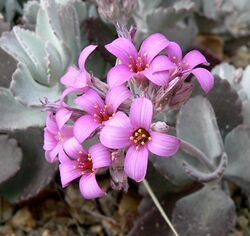Biology:Kalanchoe pumila
From HandWiki
Short description: Species of plant
| Kalanchoe pumila | |
|---|---|

| |
| K. pumila, University of California Botanical Garden | |
| Scientific classification | |
| Kingdom: | Plantae |
| Clade: | Tracheophytes |
| Clade: | Angiosperms |
| Clade: | Eudicots |
| Order: | Saxifragales |
| Family: | Crassulaceae |
| Genus: | Kalanchoe |
| Species: | K. pumila
|
| Binomial name | |
| Kalanchoe pumila Baker
| |
| Synonyms | |
|
Kalanchoe brevicaulis Baker | |
Kalanchoe pumila, the flower dust plant,[1] is a species of flowering plant in the stonecrop family Crassulaceae,[2] native to Madagascar. Growing to 20 cm (8 in) tall and 45 cm (18 in) wide, it is a spreading, dwarf succulent subshrub with arching stems of frosted leaves, and clusters of purple-veined pink flowers in spring. As the minimum temperature for cultivation is 12 °C (54 °F), in temperate regions it is grown under glass as a houseplant.[3]
The Latin specific epithet pumila means dwarf or low-growing.[4]
This plant has gained the Royal Horticultural Society's Award of Garden Merit.[5][6]
References
- ↑ "Kalanchoe pumila". https://worldofsucculents.com/kalanchoe-pumila-flower-dust-plant/.
- ↑ "Kalanchoe pumila Baker". The Trustees of the Royal Botanic Gardens, Kew. n.d.. https://powo.science.kew.org/taxon/urn:lsid:ipni.org:names:274450-1.
- ↑ RHS A-Z encyclopedia of garden plants. United Kingdom: Dorling Kindersley. 2008. pp. 1136. ISBN 978-1405332965.
- ↑ Harrison, Lorraine (2012). RHS Latin for gardeners. United Kingdom: Mitchell Beazley. pp. 224. ISBN 9781845337315.
- ↑ "RHS Plant Selector - Kalanchoe pumila". https://www.rhs.org.uk/Plants/9694/Kalanchoe-pumila/Details. Retrieved 7 September 2020.
- ↑ "AGM Plants - Ornamental". Royal Horticultural Society. July 2017. p. 56. https://www.rhs.org.uk/plants/pdfs/agm-lists/agm-ornamentals.pdf. Retrieved 14 March 2018.
Wikidata ☰ Q1722022 entry
 |

